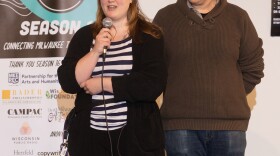Erich Lichtblau-Leskly was one of around 140,000 Jewish people forced into Theresienstadt, a ghetto-labor and transit camp, by the Nazis during the Holocaust. While facing the horrors of imprisonment and working as a slave in the camp, Leskly created art to document life in Theresienstadt.
That art, along with recreations of his art Leskly made decades after leaving the camp, is being featured in the Jewish Museum Milwaukee’s newest exhibit, “To Paint Is To Live: The Artwork of Erich Lichtblau-Leskly.”

Molly Dubin is the curator for the Jewish Museum Milwaukee. She says Leskly’s art jumps out as cartoonish and, at first, it can be jarring to see such a serious topic depicted in his style.
“When you think about trying to cope with the absolute surreal circumstances under which he and his wife, and all of those imprisoned at Theresienstadt, were a part of — it’s almost fitting. It’s this, you know, incredibly atrocious narrative juxtaposed with this very inviting, you know, vividly colored palate of pieces,” she says.

Theresienstadt was also known as a “model camp,” which meant it was kept to look nice for foreign entities like the International Red Cross to tour and for the Nazis to push propaganda that the camp was a desirable place to live for Jewish people.
Dubin says the fact that Leskly was living in this camp designed to create a false reality while creating art aimed at capturing the real experience teaches the importance of documenting truth.
“This idea of the surreal versus the reality,” she says. “Being able to get that message out to the world with something that is undeniable in the form of a documented visual account.”

This is the Jewish Museum Milwaukee’s first in-person exhibit since the pandemic began, and Dubin says that she thinks people will be able to draw connections between the past year and Leskly’s work.
“A big part of [Leskly’s art] was maintaining humanity, you know, maintaining a foothold in the creative aspect of your life and your existence that allows you to continue, you know, it’s an impetuous to continue,” she says.

Dubin also says there is no replacement for the emotional connection of being in the same room as Leskly’s work.
“There is something that you just can’t get when you are — if you are in physical proximity to an artifact or a piece of art like this, particulary the fragmented piece, there’s something that just happens that is a physical, you know, tangible feeling of understanding the history of this piece,” she says.
“To Paint Is To Live: The Artwork of Erich Lichtblau-Leskly” will be on display at the Jewish Museum Milwaukee through May 30.







